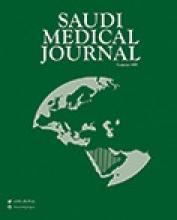Abstract
OBJECTIVE: This study was conducted to determine the Jordanian cesarean rate and to examine the related indications for cesarean section (CS) in comparison with international rates.
METHODS: Between 1990 to 2001, there were 243271 deliveries at 7 major military hospitals, (King Hussein Medical Center; Queen Alia Hospital, Amman; Prince Hashem Ben Al-Hussein Hospital, Al-Zarqa; Prince Ali Ben Al-Hussein Hospital, Al-Karaq; Prince Zaid Ben Al-Hussein, Al-Tafileh; Prince Rashid Ben Al-Hassan, Irbid; Princess Haya Al-Hussein, Aqaba) that reflect the main cities in Jordan, of which 22621 CS were performed. Two periods for the study were taken, the first from January 1990 to December 1992 and the second from January 1999 to December 2001 to examine the changes in the rate and indications for CS. Cesarean deliveries were classified according to 5 indications: breech presentation, dystocia, repeat cesareans, fetal distress and "others". Comparison by indication between the 2 periods and with the United States of America (USA) studies was discussed. Significance of differences was assessed using Chi-Square test.
RESULTS: Out of 48280 deliveries performed during the first period, 3854 CS were performed with an incidence of 8%, while 8353 CS were performed during the second period out of 76611 deliveries with an incidence of 10.9%. This difference in rate showed 2.9 per hundred deliveries increase in the cesarean rate between the 2 periods. Comparison between the 2 periods showed no significant change in CS rate for breech category (p=0.158). A highly significant increase was found for fetal distress category (p=0.000), while dystocia and repeat CS showed a high significant decrease in CS rate (p=0.000) in the second study period. Analysis of the Jordanian CS rate and related indications for the operation compared with USA reports showed a high significant increase in Jordanian cesarean rate for breech, fetal distress and "other" categories (p=0.000), while a high significant decrease for dystocia and repeat cesarean was found (p=0.000).
CONCLUSION: The lower cesarean rate in Jordan is attributed to lower frequencies of CS for dystocia, due to more accuracy in estimation of the fetal body weight, and with proper use of oxytocin dosage, which can correct malrotation of vertex leading to subsequent reduction in CS rate for dystocia. Policies, such as: active management of labor, trial of scar, maintenance of the skills required to supervise vaginal delivery when there is a breech presentation and better definition of the deliveries in which fetal monitoring will be useful in the diagnosis of fetal distress; all will achieve acceptable cesarean rate.
- Copyright: © Saudi Medical Journal
This is an open-access article distributed under the terms of the Creative Commons Attribution-Noncommercial-Share Alike 3.0 Unported, which permits unrestricted use, distribution, and reproduction in any medium, provided the original work is properly cited.






